Barber J.R. Intermediate Mechanics of Materials
Подождите немного. Документ загружается.

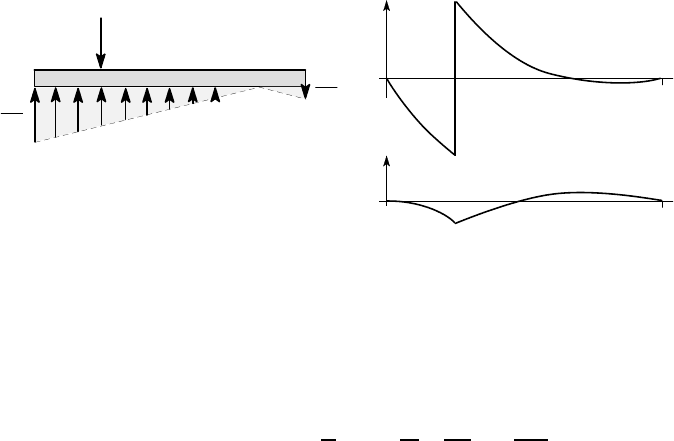
7.8 Summary 375
The last term (−W /L) in the expression for p(z) simply cancels the self-weight
w(z) =W/L and hence makes no contribution to the bending moment in the beam.
The remaining loads are shown in Figure 7.22 (a) and we can sketch the shear force
and bending moment diagrams as in Figure 7.22 (b).
F
5F
2L
F
2L
V
z
M
z
(a) (b)
Figure 7.22
It is clear from the bending moment diagram that the maximum bending moment
will occur under the load at z=L/4 and is
|M
max
| =
Z
L/4
0
zp(z)dz =
F
2
Z
L/4
0
5z
2
−
3z
2
L
=
FL
2
32
.
7.8 Summary
In this chapter, we have considered problems in which a loaded beam is supported
by an elastic foundation that provides a restoring force proportional to the local dis-
placement. The theory of beams on elastic foundations has traditionally been used in
civil engineering to model structures and railway tracks on soil foundations. How-
ever, this formalism is also a useful way of describing systems such as thin metal
components bonded to rubber, stiff fibres in a relatively flexible matrix or cartiledge
layers (the foundation) attached to bones (the beam).
The resulting deformation is localized, the displacement decaying exponentially
with distance from the loaded region at a rate which depends upon the foundation
modulus and the flexural rigidity of the beam. The first stage in any engineering de-
sign problem of this kind should always be to calculate the decay rate
β
, since the
nature of the solution depends qualitatively on its relation to the length of the beam
or to the length of the loaded region. The length scale associated with this decay
also provides criteria to assess whether a non-local support or a system of periodic
discrete supports can reasonably be approximated by a uniform local (Winkler) foun-
dation.
376 7 Beams on Elastic Foundations
For continuously loaded beams, the solution can be constructed as the sum of a
particular solution, and a homogeneous solution which describes the localized de-
formation associated with the end conditions. A general particular solution can be
written as an integral [equation (7.38)], but for many practical loading scenarios, the
result is more easily obtained directly from the governing differential equation (7.5).
For long beams, where
β
L≫1, the load is predominantly carried by the founda-
tion and bending effects are important only in a region near the supports or a discon-
tinuity in loading. The problem is then conveniently treated by finding a particular
solution for similar loading of an infinite beam and then correcting for the conditions
at each end separately, using the results for the end loading of an otherwise unloaded
semi-infinite beam (7.11).
For short beams (
β
L ≪1) the foundation has little influence on the deformation
if the beam is kinematically supported. Otherwise, the beam compresses the founda-
tion essentially as a rigid body and the arbitrary constant(s) defining this rigid-body
motion can be determined from kinematic and equilibrium arguments.
For design purposes, reasonable accuracy can be expected using the long beam
approximation for
β
L > 3 and the short beam approximation for
β
L < 1. For beams
of intermediate length, there is interaction between the conditions at the two ends
of the beam, requiring the solution of four simultaneous equations, though some
simplification can often be achieved by locating the origin of coordinates at the mid-
point of the beam and using symmetry.
Further reading
A.P. Boresi, R.J. Schmidt, and O.M. Sidebottom (1993), Advanced Mechanics of
Materials, John Wiley, New York, 5th edn., §§10.1–10.6.
R.D. Cook and W.C. Young (1985), Advanced Mechanics of Materials, Macmillan,
New York, §§5.1–5.6.
A.C. Ugural and S.K. Fenster (1995), Advanced Strength and Applied Elasticity,
Prentice-Hall, Eaglewood Cliffs, NJ, 3rd edn., Chapter 9.
Problems
Sections 7.1–7.4
7.1. A semi-infinite beam of flexural rigidity EI is supported on an elastic foundation
of modulus k and simply supported at the end. A moment M
0
is applied to the beam
at the support. Find the reaction induced at the support and the slope at the end.
7.2. A semi-infinite steel beam of second moment of area I = 5×10
6
mm
4
is sup-
ported on an elastic foundation of modulus k = 10 MPa and loaded by a moment of
20 kNm at the end. Find the slope and deflection at the end (E
steel
= 210 GPa).
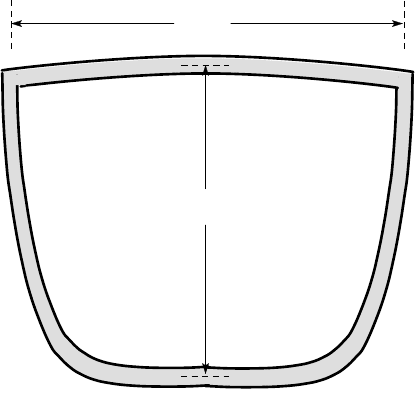
Problems 377
7.3. A long steel I-beam of second moment of area I
x
= 1.2×10
6
mm
4
is supported
on an elastic foundation of modulus 1.2 MPa. Find the force required to deflect the
end of the beam by 5 mm (E
steel
=210 GPa).
7.4. A long steel I-beam of second moment of area I
x
=3.0×10
6
mm
4
is supported on
an elastic foundation of modulus 4.0 MPa. An end force is applied so as to cause an
end deflection of 2 mm. Find the force required and the resulting maximum bending
moment in the beam (E
steel
=210 GPa).
7.5. Figure P7.5 shows the cross section of an oil tanker. Obtain an order of mag-
nitude estimate of the flexural rigidity of the section by approximating it by a 70
ft diameter hollow cylinder with a 2 inch thick steel wall (E = 30×10
6
psi). Hence
estimate the decay length l
0
for the tanker, considered as a beam on an elastic foun-
dation. Would a typical tanker be ‘long’or ‘short’ according to the criteria of §7.3?
The density of sea water is 62 lbs/ft
3
.
70 ft
65 ft
Figure P7.5
7.6. Figure P7.6 shows the cross section of a semi-infinite C254×45 steel channel
which rests on an elastic foundation of modulus k = 10 MPa and is loaded by a
downward force of 20 kN at the end. The second moment of area of the channel
for bending about the horizontal axis is I
x
= 1.64×10
6
mm
4
and the centroid C is
located at a distance 18 mm from the bottom of the section. Find the deflection at the
free end and the location and magnitude of the maximum tensile stress in the beam.
(E
steel
=210 GPa)
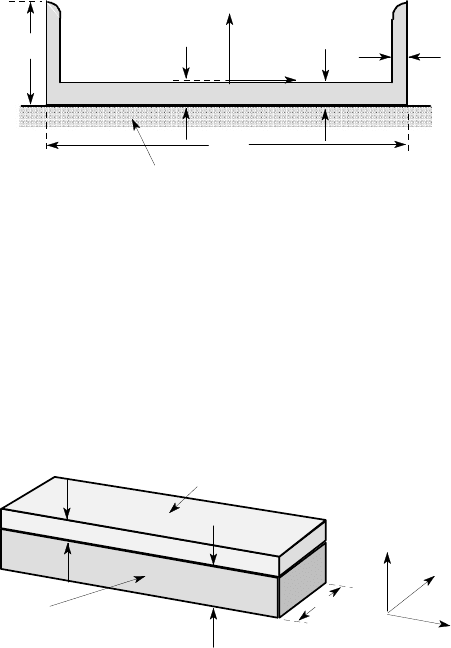
Figure P7.7
7.8. An infinite beam on an elastic foundation is loaded by a concentrated force F
0
.
What will be the percentage error in the predictions of (i) the maximum deflection
and (ii) the maximum bending moment, if the modulus k of the foundation is over-
estimated by 50%?
7.9. An air duct consists of an aluminium thin-walled tube of diameter 1 ft and wall
thickness 1/8 in. It is supported by a set of steel cables of diameter 1/8 in and length
4 feet, with an axial spacing of 3 feet, as shown in Figure P7.9. Find the characteristic
length l
0
for this system and comment on whether it can reasonably be analyzed as a
beam on an elastic foundation (E
steel
=30×10
6
psi, E
aluminium
=11×10
6
psi).
378 7 Beams on Elastic Foundations
17.1
11.1
18
254
77
x
y
C
Elastic foundation
all dimensions in mm
Figure P7.6
7.7. A mounting assembly involves a 2 mm steel strip bonded to a 4 mm rubber
layer, which in turn is supported by a rigid base, as shown in Figure P7.7. Estimate
the modulus of the rubber foundation, assuming that the out-of-plane stress
σ
xx
is
always zero. Hence, estimate the decay length l
0
for the assembly, considered as a
steel beam on a rubber foundation (E
rubber
=1.4 MPa,
ν
rubber
=0.5, E
steel
=210 GPa,
ν
steel
=0.3).
4
2
6
rubber
steel
x
y
z
all dimensions in mm
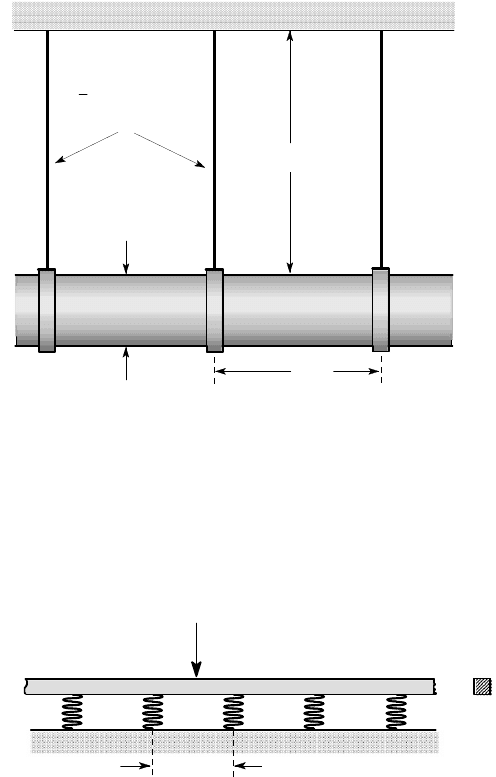
Problems 379
7.10. Figure P7.10 shows a long steel beam of 80×80 mm square cross section
supported on discrete springs of stiffness 1 kN/mm, spaced 100 mm apart. Can this
support reasonably be considered as an elastic foundation?
The beam is loaded by a force of 20 kN as shown. Find the maximum tensile
stress in the beam and the maximum force carried by any individual spring. (E
steel
=
210 GPa).
Figure P7.10
7.11. In Problem 7.10 additional springs are provided to reduce the axial spacing to
50 mm, other parameters remaining the same. Find the maximum tensile stress in the
beam and the maximum force carried by any individual spring.
Section 7.5
7.12. An infinite beam of flexural rigidity EI is supported by an elastic foundation of
modulus k and is subject to a sinusoidal load
1 ft
4 ft
3 ft
diameter
cables
"
8
1
Figure P7.9
100 mm
20 kN
80 mm
80 mm
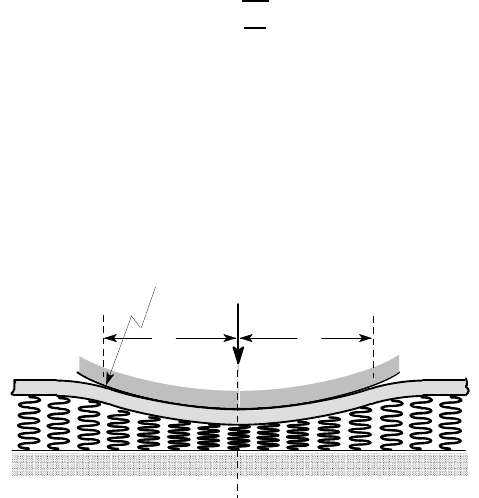
380 7 Beams on Elastic Foundations
w(z) = w
0
sin(az) ,
where a is a constant. Find the displacement u and the bending moment M as func-
tions of z and hence show that for a given value of the load amplitude w
0
, the maxi-
mum bending moment occurs when
a =
4
r
k
EI
.
7.13**. A rigid cylinder of large radius R is pressed against an infinite beam of
flexural rigidity EI supported by an elastic foundation of modulus k, as shown in
Figure P7.13. Find an expression for the force F required to establish a contact area
of length 2a in terms of R,
β
,k,a only. Find also the deflection u
0
at the mid-point
in terms of the same variables and hence obtain the (non-linear) relation between F
and u
0
.
What happens at low values of F?
7.14*. An infinite beam of flexural rigidity EI is supported by an elastic foundation
of modulus k and is loaded by a force F
0
, which is uniformly distributed over the
region −L<z< L — i.e. w(z)= F
0
/2L in this range.
Find expressions for the displacement and the bending moment as functions of z
(i) in −L <z< L and (ii) in z>L.
Hint: This problem can be solved by integration, using equation (7.38), but an
easier method is to represent the loading as the superposition of (i) a load w(z) =
F
0
/2L in −L < z < ∞ and (ii) a negative load w(z) = −F
0
/2L in L < z < ∞. These
separate problems are both similar to that treated in Example 7.3, except for a change
of origin.
7.15. Write a computer program to locate the maximum bending moment for Prob-
lem 7.14 (by finding the points where V =0).
Run the program for various values of
β
L and plot a graph of M
max
/M
0
as a
function of
β
L, where M
0
is the value of M
max
for L = 0 — i.e. M
0
is the moment
under a concentrated force F
0
and is given by equation (7.37).
a
a
F
R
Figure P7.13
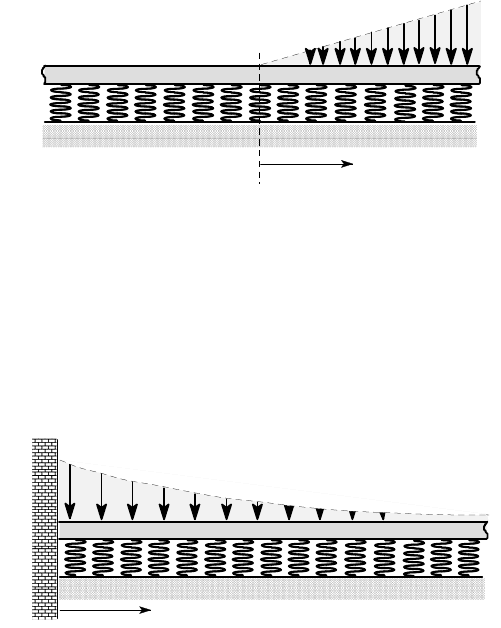
7.17. A semi-infinite beam of flexural rigidity EI is supported by an elastic founda-
tion of modulus k and built in at the end, as shown in Figure P7.17. The beam is
subjected to a distributed load
w(z) = w
0
e
−az
.
Find the bending moment at the support in terms of w
0
,a,
β
,k only.
7.18**. An infinite beam of flexural rigidity EI is supported on an elastic foundation
whose modulus is k
0
in z > 0 and 2k
0
in z < 0. The beam is subjected to a uniformly
distributed load w
0
per unit length, as shown in Figure P7.18. Find the location and
magnitude of the maximum bending moment.
z
w(z)=w exp(az) per unit length
0
Figure P7.17
Problems 381
Note that there are many places where V = 0, both under the load and in the
unloaded region. Your program must determine at which one the magnitude of the
bending moment is greatest.
7.16. Figure P7.16 shows an infinite beam of flexural rigidity EI, supported by an
elastic foundation of modulus k and subjected to a linearly varying load
w(z) = w
0
z
in z > 0. Find the bending moment in the beam as a function of z. Hence show that
the maximum bending moment occurs at O and find its magnitude.
O
z
0
w z per unit length
Figure P7.16

382 7 Beams on Elastic Foundations
Hint: Split the beam at z = 0 and then determine the moment and shear force
needed there to re-establish continuity of slope and deflection. Notice however that
β
takes different values on the two sides, so the problem is not symmetrical, in contrast
to Example 7.3.
7.19. A semi-infinite beam of flexural rigidity EI is supported by an elastic founda-
tion of modulus k and loaded by a concentrated force F a distance a from the end, as
shown in Figure P7.19. Find the deflection under the load, the deflection at the end
and the bending moment under the load.
Hint: Use the solution for a force on an infinite beam, make a cut at the point
z= −a and correct for the end conditions.
Sections 7.6, 7.7
7.20. A rectangular wooden plank of width 12 in, thickness 2 in and length 30 ft
floats on the surface of a lake. The wood has specific gravity 0.8 and Youngs modulus
E =1.6×10
6
psi and the density of water is 60 lb/ft
3
. A man weighing 150 lbs steps
carefully onto the plank at one end. Will he get his feet wet?
7.21. Figure P7.21 shows a finite beam of flexural rigidity EI loaded by a concen-
trated force F
0
at the mid-point. The beam is supported on an elastic foundation of
O
z
0
w per unit length
0
2k
0
k
Figure P7.18
F
a
Figure P7.19
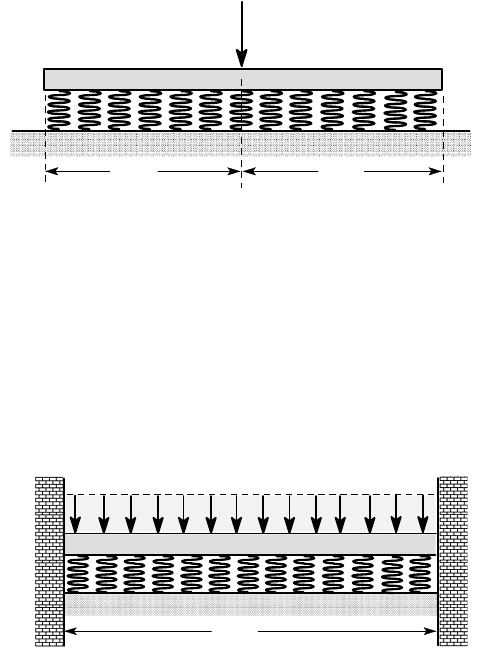
Problems 383
modulus k, but is otherwise unsupported. Find the displacement and the bending
moment at the mid-point.
7.22. Figure P7.22 shows a beam of length 2 m and flexural rigidity EI = 2×10
6
Nm
2
, subjected to a uniform load w
0
= 4 kN/m. The beam is built in at both ends
and supported on an elastic foundation of modulus k = 0.8 MPa. Find the bending
moments at the support and at the mid-point and the maximum deflection.
7.23. The oil tanker of Problem 7.5 is 500 feet long and when fully laden it rides in
still water so that the lowest point of the hull is 50 feet below the water line. In a gale,
the tanker has to traverse waves of peak-to-trough height of 18 feet and wavelength
50 feet. Estimate the maximum tensile stress generated in the hull. Will the stresses
be worse when cutting through the waves at right angles, or at an angle?
7.24. A finite beam of length L and flexural rigidity EI is built in at its ends and
supported on a foundation of modulus k. It is subjected to a uniform load w(z)=w
0
.
Find the deflection at the centre and the restraining moments at the supports for the
case where
β
L= 1.
4 kN/m
2 m
Figure P7.22
F
0
L /
2
L /
2
Figure P7.21

384 7 Beams on Elastic Foundations
7.25. A beam of length L is pinned at one end and supported on an elastic foundation
of modulus k, such that
β
L≪1. The beam is loaded by a force F at the end, as shown
in Figure P7.25. Find the location and magnitude of the maximum bending moment
and the deflection at the loaded end.
F
L
Figure P7.25
